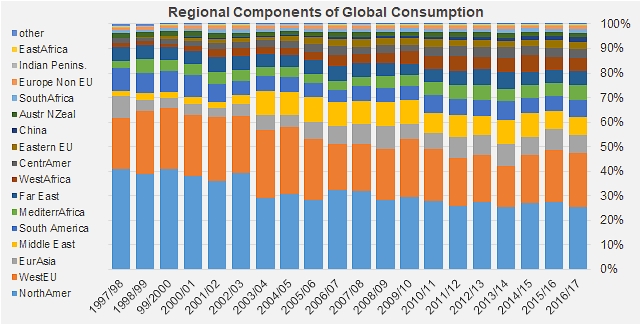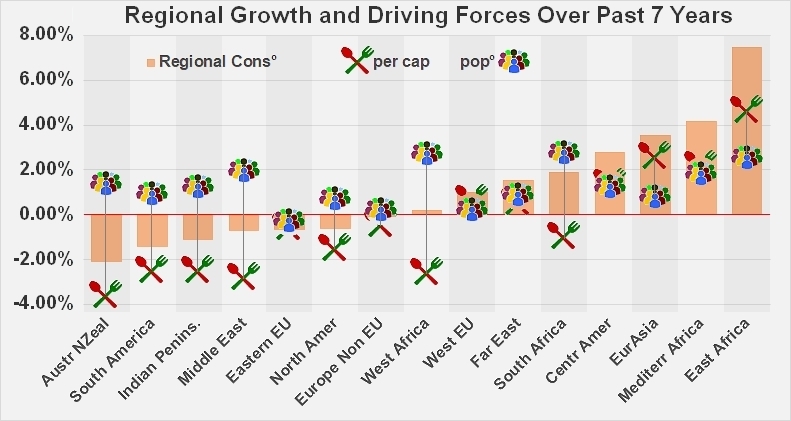Are consumption patterns decreasing, or just changing?
Regional shifts in trade patterns
The western European Union (previously EU15) and the countries of North America (USA and Canada) make up the historic basis of worldwide consumption, although other regions now record much faster annual growth rates. Over the past twenty marketing years, combined consumption for the EU28-North America region as a whole dropped from 62% to 47% of the worldwide total. The average annual growth rate of this "transatlantic" consumption region has been 2.2%, whereas it exceeded 4.7% for the rest of the world (Eurasia, Middle East, South America, Mediterranean Africa, Far East, etc.). In fact, these regions have carried most of the global growth in recent years: between 2010/2011 and 2016/2017, their accumulated performances grew at an average annual rate of 1.5%, close on thirty times faster than the growth rate of the EU-North America consumption region (0.05%).

Last year, North America accounted for one quarter of the world's consumption, with a level estimated at slightly more than 9.6 million mT of tomatoes consumed in processed form. With 8.2 million mT absorbed, the European Union virtually absorbed another quarter of the world's consumption. The third quarter corresponds to the consumption of the following four regions: Eurasia (2.9 million mT), the Middle East (2.7 million mT), South America (2.5 million mT) and Mediterranean Africa (2.3 million mT). The last quarter was consumed by the countries of 10 other regions, with the main ones being the Far East (2.2 million mT) and West Africa (1.9 million mT).
Over the period of seven years between 2010/2011 and 2016/2017, worldwide consumption patterns have tended to remain slightly positive (+0.74%), supported by the dynamics of the western EU (+1%), Eurasia (+3.6%), Mediterranean Africa (+4.2%), West Africa (+0.2%), southern Africa (+1.9%), East Africa (+7.5%), the Far East and South America.
Coming soon, Part 4: Per capita consumption
Source: IHS, Tomato News
You can find a more detailed version of this article in the TOMATO NEWS “2018 Processed Tomato Yearbook”. This 100-pages publication gives a comprehensive picture of the global tomato processing industry in 2018 with detailed production figures, a description of the industry in each of the main processing countries, a detailed analysis of trade statistics, the latest WPTC consumption study, prices of tomato paste, a summary of all articles published online in the last year and the complete industry directory.
Copies of the YEARBOOK, which was distributed to all attendees at the 13th World Processing Tomato Congress, can be purchased at a cost of 75 euros (+VAT if applicable but including global postage) from
http://www.tomatonews.com/en/get-listed_5.html
































